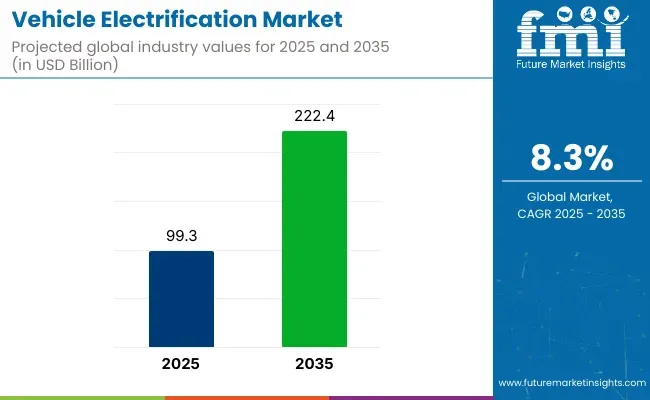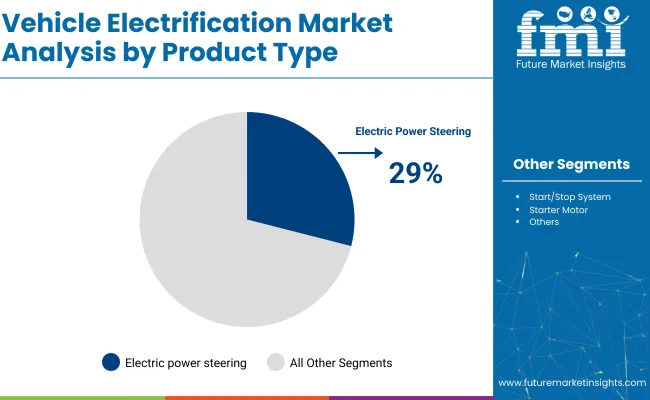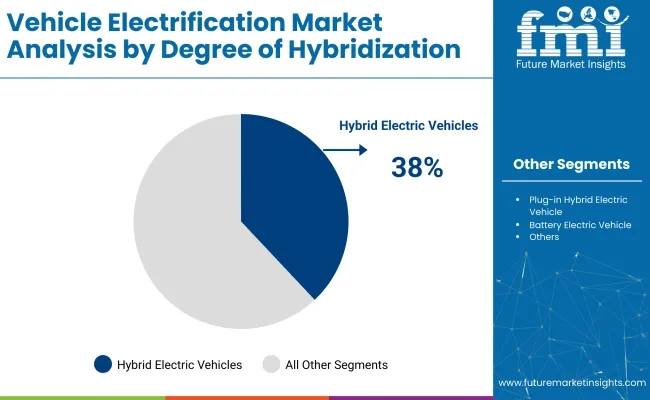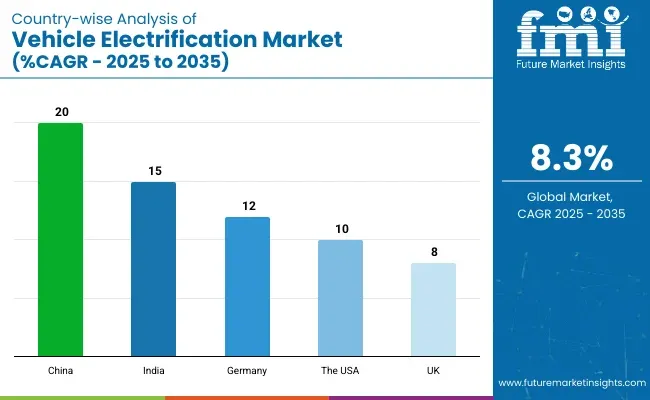The global vehicle electrification market, valued at USD 66.3 billion in 2020, is projected to grow to USD 99.3 billion by 2025. Over the forecast period from 2025 to 2035, the market is expected to expand at a compound annual growth rate (CAGR) of 8.3%, reaching a total value of USD 222.4 billion by 2035. This growth is being driven by continuous innovation in automotive electrical architecture, evolving regulatory landscapes, and increased adoption of energy-efficient systems in both passenger and commercial vehicles.
In 2024, Nissan announced the launch of an affordable vehicle-to-grid (V2G) technology, scheduled for rollout in 2026. The solution is being developed to allow electric vehicles (EVs) to serve as bi-directional energy storage units. This innovation will support grid balancing and reduce energy costs for users. According to Nissan’s global release, the technology is intended to make EV ownership more economical and to enhance energy resilience.
STMicroelectronics, in its 2025 campaign, highlighted the development of Stellar microcontrollers with extensible xMemory architecture for automotive applications. These microcontrollers were designed to handle evolving vehicle electrification needs, including zonal control, motor control, and power conversion. With scalable memory and real-time data handling capabilities, the Stellar platform has been positioned as a critical component in future hybrid and electric vehicle electronic control units.

| Attributes | Key Insights |
|---|---|
| Market Value, 2025 | USD 99.3 billion |
| Market Value, 2035 | USD 222.4 billion |
| Value CAGR (2025 to 2035) | 8.3% |
Further advancements have been observed in power delivery systems. Vicor Corporation reported increasing integration of its high-density power modules across premium EV platforms. These modules were engineered to support efficient power conversion and distribution from the battery pack to drive systems and onboard electronics. As noted in the company’s automotive innovation portfolio, the solution addresses thermal performance, compact packaging, and EMI compliance challenges in modern EV architecture.
A detailed feature in Automotive Technology underscored that 48V subsystems, advanced battery management, and e-axles are being prioritized by OEMs to balance performance with energy efficiency. These systems are being paired with predictive software and over-the-air update capabilities to future-proof vehicle electrification platforms.
With ecosystem-wide advancements and increasing convergence of software, electronics, and powertrain technologies, the vehicle electrification market is expected to maintain robust growth through 2035.
Electric power steering (EPS) accounted for 29% of the global product-type share in 2025 and is projected to grow at a CAGR of 8.6% through 2035. Adoption was driven by the need to reduce parasitic engine loads and enhance steering precision across a range of vehicle architectures.

In 2025, EPS systems were implemented across internal combustion engine (ICE), hybrid, and battery electric platforms due to their energy efficiency and compatibility with advanced driver assistance systems (ADAS). Automakers standardized EPS across compact, mid-size, and SUV models to enable smoother steering control, lane-keeping assist, and reduced maintenance relative to hydraulic systems.
Suppliers focused on reducing unit weight and improving response times to support real-time driving feedback and electronic stability programs. EPS integration remained strong in Asia-Pacific and North America due to high passenger car production volumes and tightening fuel efficiency standards.
Hybrid electric vehicles (HEVs) held 38% of the global market share by degree of hybridization in 2025 and are forecast to grow at a CAGR of 8.7% through 2035. HEVs were instrumental in scaling demand for components such as electric oil pumps, integrated starter generators (ISG), and liquid heater PTC systems. In 2025, HEV adoption increased across markets with moderate charging infrastructure where full battery electric vehicle (BEV) penetration remained limited.

Vehicle programs in Japan, South Korea, and parts of Europe prioritized HEVs for their ability to reduce fuel consumption and CO₂ emissions without requiring plug-in capabilities. Component suppliers optimized thermal management and auxiliary load control systems to meet the operating profiles of hybrid drivetrains. The use of 48V electrical architectures in HEVs further supported integration of electric actuators and power management modules, reinforcing growth across both passenger and commercial vehicle segments.
The table below presents the annual growth rates of the global vehicle electrification market from 2025 to 2035. With a base year of 2024 extending to the current year 2025, the report examines how the sector's growth trajectory evolves from the first half of the year (January to June, H1) to the second half (July to December, H2). This analysis offers stakeholders insights into the industry's performance over time, highlighting potential developments that may emerge.
These figures indicate the growth of the sector in each half-year, between the years 2024 and 2025. The industry is expected to grow at a CAGR of 8.3% from 2025 to 2035. In H2, the growth rate increases.
| Particular | Value CAGR |
|---|---|
| H1 2024 | 7.9% |
| H2 2024 | 8.1% |
| H1 2025 | 8.2% |
| H2 2025 | 8.3% |
Moving into the subsequent period, from H1 2025 to H2 2025, the CAGR is projected to slightly decrease to 4.0% in the first half and relatively increase to 4.2% in the second half. In the first half (H1), the sector saw an increase of 30 BPS, while in the second half (H2), there was a slight increase of 20 BPS.
Electric vacuum pumps boost vehicle electrification by improving efficiency and performance
Electric vacuum pumps are essential in vehicles. They provide vacuum assistance to braking systems, and power steering. In EVs, traditional engine-driven vacuum pumps are absent. The electric pumps ensure that systems like brake boosters operate effectively, and there is the rise in the electric vehicle performance. The on-demand operation and precise control helps in increasing the energy efficiently.
The growing demand for electric vehicles, and stringent emission regulations by the government authority, is propelling the electric vacuum pump in vehicle. Technological advancements, such as the development of dual-function pump systems and regenerative braking integration, are further driving market growth. These innovations not only improve vehicle efficiency but also support the broader transition to sustainable transportation solutions.
The significant rise in electric car sales, with a 35% increase in 2023 compared to 2022, reflects the broader shift toward vehicle electrification. As electric vehicle (EV) adoption grows, demand for key components like Electric Vacuum Pumps also increases. The growing electric car market, accounts for 18% of all car sales, accelerates the shift to electrification, promoting further innovations in EV components and technologies.
Government policies and initiatives promoting electric vehicle adoption and infrastructure are driving increased vehicle electrification
Government spending has significantly fuelled the adoption of electric vehicles (EVs). In 2020, governments globally invested USD 14 billion in incentives for EV purchases, marking a 25% increase from the previous year. Despite this, the share of incentives in overall EV spending dropped from 20% in 2015 to 10% in 2020, indicating the growing influence of private sector investment in the EV market.
Europe led in government spending, introducing policies to stimulate EV sales, which made EVs more accessible to consumers. In contrast, China reduced incentives as eligibility tightened. The introduction of price caps on subsidies helped reduce EV prices, making them more competitive.
For instance, BEVs in China became 3% cheaper in 2020, while PHEVs in Europe saw an 8% price drop. These factors collectively drive vehicle electrification by making EVs more affordable and supporting broader adoption aligned with sustainability goals.
EPS emerges as a leading technology for vehicle electrification, delivering efficiency gains, weight reduction, and advanced functionality
Electric Power Steering systems (EPS) are playing a significant role in driving the push for vehicle electrification. Unlike traditional hydraulic steering, EPS uses an electric motor to assist steering, offering advantages, such as reduced weight, improved fuel efficiency, and the ability to integrate advanced features like lane-keeping assistance and automated driving. As automakers shift toward electric vehicles (EVs), EPS is becoming a standard technology due to its compatibility with the electric powertrain.
The growing adoption of EPS systems in both conventional and electric vehicles aligns with the trend of reducing mechanical complexity and increasing energy efficiency. EPS also contributes to improved driving experience, with responsive steering that adjusts to driving conditions. As EVs make up an increasing portion of global car sales, the demand for EPS technology is expected to rise, further accelerating vehicle electrification and reinforcing the industry's focus on innovation and sustainability.
According to the USA Department of Energy, EPS systems can improve fuel economy by 1-3%. As of 2020, the International Energy Agency (IEA) reported that over 60% of new vehicles globally were equipped with EPS. This trend supports the growing adoption of electric vehicles (EVs) and autonomous features.
Electric Air-Conditioner Compressors Boost EV Efficiency, Comfort, and Sustainability in Vehicle Electrification
The Electric Air-Conditioner Compressor plays an important role in vehicle electrification. Unlike traditional belt-driven compressors, e-ACCs are powered directly by the electric motor, eliminating mechanical belts, which result in reducing weight and complexity. This, in turn, boosts the overall energy efficiency of EVs. According to a report by the International Energy Agency (IEA), this weight reduction contributes to improved vehicle range and performance.
Furthermore, e-ACCs are optimized to work seamlessly with the electric powertrain, ensuring minimal energy consumption while maintaining passenger comfort. As EVs rely solely on battery power, reducing demand on internal combustion systems for auxiliary functions like air conditioning is crucial.
The e-ACC ensures efficient climate control without compromising range. With global EV sales rising by 35% in 2023, the demand for energy-efficient technologies like e-ACCs is accelerating, making them essential in the transition to sustainable, electrified transportation.
Tier-1 companies account for around 50-55% of the overall market with a product revenue from the vehicle electrification market of more than USD 50 million. Some of the key plyers in this category includes Robert Bosch GmbH, Continental AG, Denso Corporation, Hitachi, Ltd., and other players serving the vehicle electrification sector.
Tier-2 and other companies such as JTEKT Corporation, Aisin Corporation and others are projected to account for 45-50% of the overall market with the estimated product revenue under the range of USD 50 million.
The section below covers the industry analysis for vehicle electrification in different countries. The demand analysis on key countries in several regions of the globe, including North America, Latin America, East Asia, South Asia Pacific, Western Europe, Eastern Europe, Middle East, and Africa is provided. This data helps investors to keenly observe and go through the recent trends and examine them in an ordered manner.
| Countries | Value CAGR (2025 to 2035) |
|---|---|
| China | 20% |
| India | 15% |
| Germany | 12% |
| The USA | 10% |
| UK | 8% |

China’s vehicle electrification is driven by government policies and manufacturing leadership. The government has set a target of 25% EV adoption by 2025, offering incentives like subsidies and tax breaks to boost both production and consumer demand. This policy support has fuelled a rapid rise in electric vehicle (EV) adoption.
China leads global EV production, with companies like BYD and NIO scaling up manufacturing, making EVs more affordable. In 2023, China accounted for over 60% of global EV sales, showcasing its dominance in the market.
The country's rapid urbanization and severe pollution levels further accelerate the transition to electric mobility, as EVs, especially Battery Electric Vehicles (BEVs), provide a solution to reduce emissions in densely populated cities. Electric Power Steering (EPS) is key in enhancing EV efficiency. By 2023, over 70% of new vehicles in China were equipped with EPS, improving energy consumption and supporting the transition to sustainable transportation.
The rise in adoption of electric oil pumps and Integrated Starter Generators (ISG) by manufacturers is significantly fuelling vehicle electrification in Germany. These advanced components are pivotal in enhancing the efficiency and performance of electric and hybrid vehicles.
Electric oil pumps help reduce mechanical losses by replacing traditional belt-driven pumps, improving the overall energy efficiency of the powertrain. This is particularly important in Hybrid Electric Vehicles (HEVs) and Plug-In Hybrid Electric Vehicles (PHEVs), where energy conservation is key. German automakers, such as Volkswagen and BMW, are integrating these components into their vehicles to optimize fuel efficiency and extend the range of electric vehicles (EVs).
Integrated Starter Generators (ISG) are driving the adoption of mild hybrid systems (48 Volts), which assist in energy regeneration during braking and provide power for other vehicle functions. This allows for reduced fuel consumption, lower emissions, and greater overall vehicle efficiency.
The increasing adoption of Electric Vacuum Pumps (EVPs) is playing a pivotal role in accelerating vehicle electrification in the USA. Unlike traditional mechanical vacuum pumps, which are powered by the internal combustion engine (ICE), EVPs are directly driven by the vehicle’s electric motor. This transition is particularly crucial for Battery Electric Vehicles (BEVs) and Plug-In Hybrid Electric Vehicles (PHEVs), which rely on electric systems rather than an ICE.
The growing consumer demand for energy-efficient and environmentally friendly vehicles, alongside stricter emissions regulations, automakers are increasingly integrating EVPs into their designs. These electric pumps provide enhanced precision in controlling braking, steering, and other vital systems, all while reducing energy consumption and eliminating the need for engine power.
Easy integration of electric vacuum pumps in Battery Electric Vehicles and Plug-In Hybrid Electric Vehicles
The easy integration of electric vacuum pumps (EVPs) in Battery Electric Vehicles (BEVs) and Plug-In Hybrid Electric Vehicles (PHEVs) has positioned them as a dominant component in vehicle electrification. Unlike traditional vacuum pumps, which rely on internal combustion engines (ICE), EVPs are powered directly by the vehicle's electric motor, making them essential for vehicles with electric powertrains.
Their ability to function without a running engine allows for improved system performance, such as precise braking and steering control, crucial for the safety and efficiency of electric vehicles. The simple and efficient integration of EVPs also contributes to reducing mechanical complexity and vehicle weight.
This enables manufacturers to optimize space, improve battery design, and enhance overall vehicle architecture. As the adoption of BEVs and PHEVs grows, EVPs are becoming an indispensable part of the electrification process, solidifying their dominance in the automotive sector.
ICE & Micro-Hybrid vehicles drive hybridization, bridging the gap to full electrification
The dominance of Internal Combustion Engine (ICE) & Micro-Hybrid Vehicles in the hybridization segment is driven by their ability to combine traditional engine technology with emerging hybrid systems. This approach enables a seamless transition toward vehicle electrification without completely abandoning internal combustion engines.
In micro-hybrid vehicles, features like Start-Stop Systems and Electric Power Steering (EPS) improve fuel efficiency and reduce emissions without compromising performance. These vehicles still rely on an internal combustion engine but integrate electrical components to aid energy regeneration and enhance efficiency. The lower investment in electric infrastructure makes micro-hybrids more affordable and accessible compared to fully electric or plug-in hybrid vehicles.
ICE & micro-hybrid vehicles fuel vehicle electrification by providing a low-cost, accessible entry point into eco-friendly transportation. They allow consumers and automakers to gradually adopt hybrid technologies while maintaining the familiarity of traditional engines, ultimately supporting a smoother shift toward complete electrification
Recent Industry Developments
The product type is further categorized into electric power steering (EPS), start/stop system, electric air-conditioner compressor, electric vacuum pump, electric oil pump, electric water pump, liquid heater PTC, integrated starter generator (ISG), starter motor, alternator and actuator.
The degree of hybridization is classified into internal combustion engine (ICE) & micro-hybrid vehicle, hybrid electric vehicle (HEV), plug-in hybrid electric vehicle (PHEV), battery electric vehicle (BEV) and mild hybrid system .
Regions considered in the study include North America, Latin America, Western Europe, Eastern Europe, East Asia, South Asia & Pacific, and the Middle East and Africa.
The vehicle electrification market was valued at USD 91.6 billion in 2024.
The demand for vehicle electrification is set to reach USD 99.3 billion in 2025.
The global vehicle electrification market is driven by stricter emission regulations, advancements in battery technology, government incentives and automakers' transition to electric models.
The vehicle electrification market is projected to reach USD 222.4 billion in 2035
The Electric Vacuum Pump are expected to lead during the forecasted period due to their ability to provide reliable brake assistance in electric and hybrid vehicles, replacing mechanical pumps, and enhancing system efficiency.






Full Research Suite comprises of:
Market outlook & trends analysis
Interviews & case studies
Strategic recommendations
Vendor profiles & capabilities analysis
5-year forecasts
8 regions and 60+ country-level data splits
Market segment data splits
12 months of continuous data updates
DELIVERED AS:
PDF EXCEL ONLINE
Military Vehicle Electrification Market Size and Share Forecast Outlook 2025 to 2035
Vehicle Transfer Case Market Size and Share Forecast Outlook 2025 to 2035
Vehicle Barrier System Market Size and Share Forecast Outlook 2025 to 2035
Vehicle Acoustic DSP Chips Market Size and Share Forecast Outlook 2025 to 2035
Vehicle Cargo Box Market Size and Share Forecast Outlook 2025 to 2035
Vehicle Jump Starter Market Size and Share Forecast Outlook 2025 to 2035
Vehicle Moving Services Market Size and Share Forecast Outlook 2025 to 2035
Vehicle Security Sensor Market Size and Share Forecast Outlook 2025 to 2035
Vehicle To Vehicle Communication Market Size and Share Forecast Outlook 2025 to 2035
Vehicle Roadside Assistance Market Size and Share Forecast Outlook 2025 to 2035
Vehicle as a Service Market Size and Share Forecast Outlook 2025 to 2035
Vehicle Integrated Solar Panels Market Size and Share Forecast Outlook 2025 to 2035
Vehicle Networking Market Size and Share Forecast Outlook 2025 to 2035
Vehicle-to-Everything (V2X) Cybersecurity Market Size and Share Forecast Outlook 2025 to 2035
Vehicle Armor Market Size and Share Forecast Outlook 2025 to 2035
Vehicle Conversion Market Size and Share Forecast Outlook 2025 to 2035
Vehicle Health Monitoring Market Size and Share Forecast Outlook 2025 to 2035
Vehicle Tracking System Market Size and Share Forecast Outlook 2025 to 2035
Vehicle Radar Test System Market Size and Share Forecast Outlook 2025 to 2035
Vehicle Interior Air Quality Monitoring Technology Market Analysis - Size, Share, and Forecast Outlook 2025 to 2035

Thank you!
You will receive an email from our Business Development Manager. Please be sure to check your SPAM/JUNK folder too.
Chat With
MaRIA